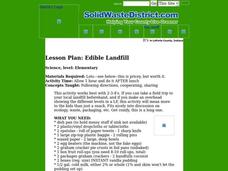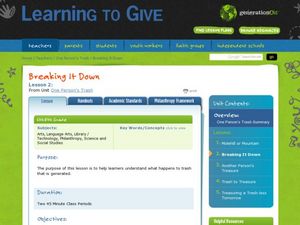Science Matters
Volcano Models
More than 80 percent of the earth's surface originated from volcanoes. The 16th lesson in a 20-part series introduces the shape and development of volcanoes. It begins with a demonstration using a balloon and flour to illustrate the...
Curated OER
Dirt Cups
After a hard day examining and dissecting worms, why not put your feet up and snack on a few? Here is a really cute idea that can be used to celebrate Earth Day or to accent a thematic learning experience. Kids use clay pots, gummy...
Recycle OK
The Incredible Edible Landfill
Create an edible class model of a landfill using pudding, graham crackers, cookies, and licorice. After making the landfill model, the class discusses what each part represents and answers some other landfill-related questions. Then they...
Curated OER
Edible Soils
Students create soil profiles, including rock, clay, silt, sand, and humus, in clear plastic cups out of edible materials.
American Museum of Natural History
Global Grocery
A walk through the grocery store is like a walk around the world. An interactive activity shows popular grocery items and where the ingredients originate. Perfect as a remote learning resource, the lesson connects groceries to the...
Curated OER
Edible Landfill
Young scholars investigate landfills. In this edible landfill instructional activity, students replicate the structure sanitary landfills as they use the listed foods to build a model.
Curated OER
Ant City
Students develop an ant colony that adults and children can visit. Students create different areas including places where tourists can view live ants, play ant games, research facts about ants, and create ant art. Students serve as...
Curated OER
Pigs
Learners read books, learn about the letter p, and eat pigs n mud all to learn about pigs. In this pigs lesson plan, students also dance with pink ribbons and make pigs out of construction paper.
Curated OER
Edible Landfill
Students identify the parts of a landfill. In this ecology lesson, students use various ingredients to create an edible landfill snack. For example, students use fruit roll-ups for plastic liner and crushed graham crackers for gravel.
Curated OER
Edible Soil
Students examine the components of the soil in their community. Following directions, they create their own edible soil to be eaten at the end of the activity. They discuss what makes soils around the world different from those found...
Curated OER
Gifts From the Sea
In this marine animal worksheet, 3rd graders study the parts of seaweed. Students label 2 seaweed diagrams and study 24 household objects, circling those that come from seaweed extracts and/or ingredients.
Curated OER
One Person's Trash: Breaking it down
Students research how trash is disposed of and make an edible landfill. In this trash lesson plan, students research proper trash disposal, and discuss how trash affects the community. Then they make an edible landfill.
Curated OER
What Foods Contain Products from the Ocean
Fifth graders learn about foods from the ocean. In this ocean products lesson, 5th graders brainstorm what foods come from the ocean, fill in a Venn Diagram comparing alginates, carrageenans and beta carotenes. Students make...
Curated OER
There Are Algae in Your House!
Students demonstrate that, although we sometimes can neither smell nor taste them, many ingredients in our foods and household products come from the sea. They also investigate food eat to determine algae derivatives they contain.
Curated OER
Is There Seaweed/Algae in Your Food?
Young scholars discover that seaweed/algae is a small part of the resources the oceans provide. By investigating common household products, students discover that human senses are not enough to detect the presence of seaweed/algae in food.
Curated OER
New Boxes from Old
Ninth graders take a rectangular box (e.g., a cereal box) and cut it up to make a new, cubical box with the same volume as the original. In so doing, they will discover that because the cubical box has less surface area than the...
Curated OER
It’s Your Trash!
Students identify the different sections of a landfill. In this ecology lesson, students brainstorm ways that they can help in proper trash disposal. They write a reflection journal about their thoughts on the subject.


















